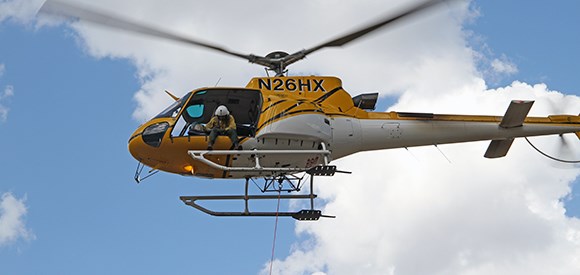Last updated: December 14, 2017
Article
Short-Haul-Capable Helicopter, Crew Performs Rescue at Grand Teton

Risk management is a key component to responding to wildfires, and determining how to safely and effectively rescue an injured firefighter in the rugged backcountry is crucial to successful incident management. For a wildland firefighter, getting struck by a snag is a major concern, especially in a remote area where getting prompt medical attention is difficult. On August 27, 2013, a snag struck a Chena Hotshot assigned to the Kelley fire on the Sawtooth National Forest. Thanks to the short-haul-capable Teton Interagency helicopter and crew members, the hotshot was quickly rescued off the mountain and provided emergency medical care.
Immediately after the accident, the Chena superintendent requested a medical evacuation, prompting air attack to request an air ambulance and a hoist-capable helicopter. Hearing the radio traffic, a Teton Interagency Helitack crew member assigned to the helibase notified air attack that the crew and helicopter N26HX, which was conducting water drops from a dip site near helibase, were short-haul-capable. Short-haul is a rescue technique in which an individual is suspended below the helicopter on a 100- to 200-foot rope. This method allows a rescuer more direct access to an injured party, and it is often used in national parks such as Grand Teton National Park in the Teton Range, where conditions make it difficult to land a helicopter in the steep and rocky terrain. Patients are typically flown out via short-haul with a ranger attending to them below the helicopter.
Operations diverted the helicopter from the water bucket mission, and the crew began preparing for a short-haul. Pilot Chris Templeton and short-haul spotter Garth Wagner flew a reconnaissance mission. Tasks included locating a suitable insertion spot, conducting environmental and power checks, and determining that a short-haul mission was the appropriate tool. Based on the recon flight, the crew completed a short-haul and Green-Amber-Red (GAR) risk assessment, then readied for the mission. They configured the helicopter by removing the doors, attaching a “three-ring” backup to the cargo hook, and inspecting and attaching a 150-foot-long short-haul rope to the cargo hook. They also checked the harnesses for the short-hauler and spotter, as well as the communication systems. A litter was prepared with a harness and attachment points.
While the helitack crew was preparing helicopter N26HX for short-haul, another helicopter delivered medical gear to the site of the injured firefighter. An EMT on the Chena Hotshots and other crew members prepared the patient for transport. The helicopter inserted short-hauler Ron Johnson, whose normal job is as a Jenny Lake climbing ranger at Grand Teton National Park, with a litter and line gear into the extraction site. Rescuers transported the patient on a spine board the 150 feet to the extraction site. Because the patient was already packaged, the helicopter extracted him and the short-hauler about 15 minutes after inserting Johnson on site. They were flown back to helibase, where a team of Teton Helitack members caught the patient and litter and transferred him to a waiting life-flight helicopter.
During the week before the successful rescue mission, the Teton Helitack crew flew nearly three hours of short-haul training in typical terrain for pilot proficiency. Such proficiency training is required every 28 days, and in this case, the training was also essential in preparing the helitack crew to receive the patient and litter at helibase.
Using the short-haul method is relatively new to wildland fire, but it’s one of the preferred methods of rescue in the rugged terrain of several national parks, including Grand Teton, Yellowstone, Yosemite, Zion, and Grand Canyon. The Yosemite Helitack crew performed a successful rescue earlier in August on the Green Ridge fire on the Deschutes National Forest.
Contacts: Chip Collins, Grand Teton fire management officer
Email: e-mail us
Phone: (307) 739-3310
